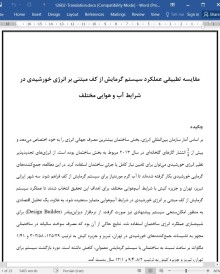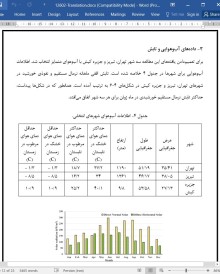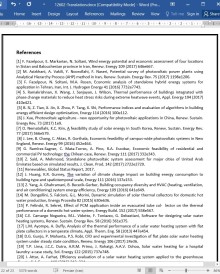
دانلود مقاله مقایسه تطبیقی عملکرد سیستم گرمایش از کف مبتنی بر انرژی خورشیدی در شرایط آب و هوایی مختلف
چکیده
بر اساس آمار سازمان بینالمللی انرژی، بخش ساختمان بیشترین مصرف جهانی انرژی را به خود اختصاص میدهد و بیش از 1/3 انتشار گازهای گلخانهای در سال 2013 مربوط به بخش ساختمان بوده است. از انرژیهای تجدیدپذیر نظیر انرژی خورشیدی میتوان برای تامین نیاز کامل یا جزئی ساختمان استفاده کرد. در این مطالعه، جمعکنندههای گرمایی خورشیدی بکار گرفته شدهاند تا آب گرم موردنیاز برای سیستم گرمایش از کف فراهم شود. سه شهر ایرانی تبریز، تهران و جزیره کیش با شرایط آبوهوایی مختلف برای اهداف این تحقیق انتخاب شدند تا عملکرد سیستم گرمایش از کف مبتنی بر انرژی خورشیدی در شرایط آبوهوایی متمایز سنجیده شود. به علاوه، یک تحلیل اقتصادی به منظور امکانسنجی سیستم پیشنهادی نیز صورت گرفت. از نرمافزار دیزاینبیلدر (Design Builder) برای شبیهسازی عملکرد انرژی ساختمان استفاده شد. نتایج حاکی از آن بود که مصرف سوخت سالیانه در ساختمانی مجهز به تاسیسات جمعکنندههای خورشیدی در تهران، تبریز و جزیره کیش به ترتیب 39/125، 58/303 و 41/1 مگاوات بر ساعت نسبت به ساختمانی با سیستم گرمایشی معمولی، کاهش داشته است. دوره بازگشت سیستم برای تهران، تبریز و جزیره کیش به ترتیب 2/8، 4/9 و 1/12 سال بدست آمد.
1-مقدمه
کاهش منابع سوخت فسیلی، گرمشدن زمین، صنعتیشدن و رشد جمعیت چالشهایی را پیشروی بخش انرژی قرار داده است. اکنون، بخش ساختمان تقریباً 40% از کل مصرف انرژی را به خود اختصاص میدهد و در سال 2013 میلادی 30% از انتشار گازهای گلخانهای را به خود اختصاص داده است. انرژیهای تجدیدپذیر نظیر انرژی خورشیدی میتواند برای برآورده کردن نیازهای برق، گرمایش و سرمایش ساختمانهایی که از جمعکنندههای خورشیدی و یا فوتوولتائیک بکار گرفته شود و در عین حال تولید کربن مضر نیز کاهش مییابد. سیستمهای گرمایش خورشیدی به طور گستردهای برای اهداف گرمایشی و سرمایشی مورد بهرهبرداری قرار گرفتهاند. کل ظرفیت جهانی نصبشده سیستمهای گرمایش خورشیدی به 456 گیگاوات در پایان سال 2016 رسیده است.
سیستمهای تهویه، تهویه مطبوع و گرمایشی اصلیترین مصرفکننده انرژی در ساختمانها به حساب میآیند. سیستمهای گرمایش خورشیدی و فوتوولتائیک میتواند در ساختمانها نصب شود تا بخشی از نیاز آنها به برق، گرمایش و سرمایش را تامین کنند. با این حال، پیش از نصب این نوع سیستمها، باید امکانسنجی را هم از لحاظ فنی و هم از لحاظ اقتصادی انجام داد تا از ریسک سرمایهگذاری جلوگیری شود و از قابلیتاطمینان و پایداری سیستمها مطمئن شد.
اکثر پژوهشهای صورتگرفته تمرکز خود را به جنبههای فنی، اقتصادی و زیستمحیطی ساختمانها با توجه به سیستمهای گرمایش خورشیدی و فوتوولتائیک معطوف ساختهاند. در یک پژوهش، روشی دینامیک برای بررسیکردن میزان تولید آبگرم با استفاده از جمعکنندههای گرمایی مبتنی بر انرژی خورشید توسعه یافت. آن مطالعه نشان داد که شاخص میزانِ تامین انرژی ساختمان از انرژی خورشیدی به شکل نزدیکی با مصرف آب روزانه در ساختمان مرتبط است. بهرهگیری از مواد تغییرفازدهنده در تجمیعکنندههای لولهای خورشیدی بررسی شد تا افزایش عملکرد جمعکنندهها ارزیابی شود. بهرهوری سیستمهایی که از مواد تغییرفازدهنده استفاده کردهبودند از 30% تا 70% متغیر است و به دمای مواد تغییرفازدهنده و همچنین میزان تابش خورشیدی وابسته است. ظرفیت این نوع جمعکنندهها نسبت به جمعکنندههای معمولی سالانه تا 5/20% ارتقا یافت. برای بهبود بخشیدن به دقت طراحی در سیستمهای گرمایش آب خورشیدی، نوگیرا و همکاران برنامهای را به کمک مطلب (Matlab) توسعه دادند که کاربران را قادر میسازد انواع مدلهای جمعکننده خورشیدی را با استفاده از تجهیزات کمکی مدلسازی کنند. عملکرد گرمایی یک جمعکننده خورشیدی با صفحه تخت 4 متر مربعی برای گرمایش آب به طور تجربی در طول یک سال در شهر دوبلین کشور ایرلند اندازهگیری شده است. مصرف انرژی روزانه به طور متوسط، هدررفت از لولهها و کسر انرژی خورشیدی (نسبت انرژی خورشیدی تولیدی به کل انرژی موردنیاز) به ترتیب 6/19 مگاژول به ازای هر روز، 2/3 مگاژول به ازای هر روز و 2/32 % بوده است. تاثیر نرخ جریان جرمی، آب ورودی و دمای محیط و خورتابگیری (insolation) خورشیدی بر عملکرد گرمایی سیستمهای گرمایش آب در حلقه بسته و باز آزموده شدند. آن مطالعه نشان داد که بهرهوری سیستم با افزایش نرخ جریان جرمی در جمعکنندههای خورشیدی، دمای محیط و خورتابگیری خورشیدی افزایش نشان میدهد.
5- نتیجهگیری
در این مطالعه، امکانسنجی برای سیستم گرمایش از کف مبتنی بر انرژی خورشدی برای سه شهر ایرانی با سه آبوهوای متمایز انجام شد. ساختمانی با و بدون جمعکنندههای خورشیدی در نرمافزار دیزاین بیلدر شبیهسازی شد. آنگاه یک ارزیابی اقتصادی صورت گرفت تا بهرهگیری از سیستمهای پیشگفته مورد ارزیابی قرار بگیرد. نتیجهگیریهای زیر از یافتههای این مطالعه حاصل شدهاند:
- دمای هوای داخلی ساختمانی که مجهز به تاسیسات جمعکننده بوده است و در تهران و تبریز قرار داشته است، بیشتر از سیستم معمولی مستعد نوسانان بوده است. با این حال در جزیره کیش دمای هوای داخلی ساختمان ثابت باقی مانده است.
- بهرهگیری از سیستم گرمایش از کف مبتنی بر انرژی خورشدی میتواند مصرف سالانه سوخت را در تهران تا MWh 125 در تبریز تا MWh 300 و در کیش تا MWh 4/1 کاهش دهد.
- در حین طول عمر سیستمهای ساختمان، بیش از 570 تن در تهران، 1400 تن در تبریز و 5/6 تن در جزیره کیش انتشار گازهای گلخانهای میتواند به دلیل استفاده از جمعکنندههای خورشیدی کاهش یابد.
- دورههای بازگشت سرمایه با استفاده از سیستم گرمایش از کف مبتنی بر انرژی خورشدی در تهران، تبریز و کیش به ترتیب 2/8، 4/9 و 1/12 سال بوده است.
رویهم رفته میتوان به این نتیجه رسید که عملکرد سیستم گرمایشی خورشیدی بهتر از عملکرد سیستم گرمایشی معمولی است چون مصرف سوخت و گازهای گلخانهای را کاهش می دهد. با این وجود، اگر به جنبههای فنی، اصتقادی و زیستمحیطی توجه کنیم، این نوع سیستمها عملکرد بهتری در شرایط آبوهوایی سرد دارند. به نظر میرسد که مطالعات آتی ارزشمند هستند که جمعکنندههای خورشیدی متفاوتی را در نظر بگیرند و امکانِ نصبِ سیستم سرمایشی خورشیدی و بهرهگیری از سیستمهای فوتوولتائیک برای تامین همزمان نیازهای گرمایشی و برق ساختمان را بررسی کنند.
Abstract
According to the International Energy Agency, buildings are the largest energy-consuming sector globally, producing over one-third of greenhouse gas emissions in 2013. Renewable energies such as solar can be harnessed to fully or partially meet the energy demands of buildings. In this study, solar thermal collectors are used in a building to provide the hot water required for an underfloor heating system. Three cities in Iran, namely Tabriz, Tehran and Kish island, with distinctive climatic conditions are considered to gain a better understanding of the performance of solar-powered underfloor heating systems in different climates. Moreover, an economic analysis is conducted to assess the feasibility of the proposed system. DesignBuilder software is applied to simulate the energy performance of the building. The results indicate that the annual fuel consumption of the building with a solar collector located in Tehran, Tabriz and Kish island is reduced by 125.39, 303.58 and 1.41 MWh compared to that of without collector, respectively. The payback period of the system for Tehran, Tabriz and Kish Island is found to be 8.2, 9.4 and 12.1 years, respectively.
1. Introduction
Depletion of fossil resources, global warming, industrialization and growing population pose challenges to the energy sector [1e3]. The building sector presently accounts for approximately 40% of global energy consumption, producing 30% of annual greenhouse gas (GHG) emissions in 2013 [4,5]. Renewable energies such as solar can be harnessed to meet the electricity, heating and cooling demands of buildings using photovoltaic (PV) or solar thermal collectors, with a reduced carbon footprint [6]. Solar thermal systems have been widely used throughout the world for heating and cooling purposes [7e10]. The global installed capacity of solar thermal systems reached 456 GW by the end of 2016 [11].
Heating, ventilation and air conditioning (HVAC) systems are the primary energy consumers in buildings [12,13]. PV and solar thermal systems can be implemented in buildings, to meet some or all of the electrical, heating and cooling demands. However; prior to installation of these systems, the feasibility needs to be assessed in both technical and economic terms to avoid investment risks as well as to ensure the reliability and sustainability of the system.
Much research has been reported on the technical, economic and environmental aspects of buildings integrated with PV and solar thermal systems. A dynamic approach was adopted to investigate domestic hot water (DHW) production using solar thermal collectors [14]. That study showed that the solar coverage factor correlates closely with daily water consumption. The application of phase change materials (PCMs) in evacuated tube solar collectors was examined to enhance the performance of the collectors [15]. The charging efficiency of PCM integrated collectors varies from 30 to 70%, depending on PCM temperature and solar radiation level. The annual solar fraction of these collectors increases by 20.5% compared with conventional solar collectors. To improve the design accuracy of solar water heating systems, Nogueira et al. developed a program in MATLAB that enables users to model different types of solar collectors with auxiliary equipment [16]. The thermal performance of a 4 m2 solar flat plate collector for water heating was experimentally studied over a oneyear period in Dublin, Ireland [17]. The annual mean daily energy, pipe losses and solar fraction were found to be 19.6 MJ/d, 3.2 MJ/ d and 32.2%, respectively. The effects of mass flow rate, inlet water and ambient temperature and solar insolation on thermal performance of open and closed loop solar water heating systems was examined [18]. That study showed that the efficiency of the system improves with increasing mass flow rate in the solar collectors, ambient temperature and solar insolation.
5. Conclusions
In this study, the feasibility of solar-assisted underfloor heating systems was assessed for three cities of Iran with distinctive climates. A building with and without solar thermal collectors was simulated in DesignBuilder software. Then, an economic assessment was carried out to assess the feasibility of utilization of the aforementioned systems. The following conclusion can be drawn from the findings:
- The indoor air temperature of the building integrated with solar collectors located in Tehran and Tabriz, is liable to fluctuations. However, for Kish island, the temperature remains constant.
- The utilization of solar-powered underfloor floor heating can reduce the annual fuel consumption by 125 MWh in Tehran, 300 MWh in Tabriz and 1.4 MWh in Kish island.
- During the lifespans of the building systems, over 570 tonnes in Tehran, 1400 tonnes in Tabriz and 6.5 tonnes in Kish island of GHG emissions can be avoided by using solar collectors.
- The payback periods of the solar-powered system for Tehran, Tabriz and Kish island are 8.2, 9.4 and 12.1 years, respectively.
Overall, it can be concluded that the solar-powered heating system outperforms the conventional one since it requires less fuel and reduces GHG emissions. However, the system performs better in cold climates, when considering the economic, technical and environmental aspects. Future studies appear to be merited that consider different types of solar thermal collectors, the possibility of incorporating solar cooling in the building, and the use of PVT systems in the building to simultaneously meet the heating and electrical demands.
چکیده
1-مقدمه
2- روششناسی
2-1 توصیف ساختمان
2-2 طراحی جمعکننده خورشیدی
2-2-1 اعتبارسنجی
3- دادههای آبوهوایی و تابش
4- نتایج و بحث
4-1 یافتههای شبیهسازی
4-2 مصرف سوخت و انتشار گاز دیاکسید کربن
4-3 ارزیابی اقتصادی
5- نتیجهگیری
منابع
Abstract
1. Introduction
2. Methodology
2.1. Building description
2.2. Solar collector design
2.2.1. Validation
3. Climatic and solar radiation data
4. Results and discussion
4.1. Simulation results
4.2. Fuel consumption and CO2 emissions
4.3. Economic assessment
5. Conclusions
References
- اصل مقاله انگلیسی با فرمت ورد (word) با قابلیت ویرایش
- ترجمه فارسی مقاله با فرمت ورد (word) با قابلیت ویرایش، بدون آرم سایت ای ترجمه
- ترجمه فارسی مقاله با فرمت pdf، بدون آرم سایت ای ترجمه



